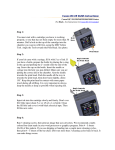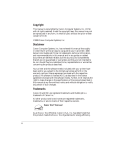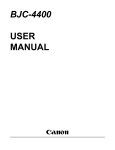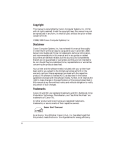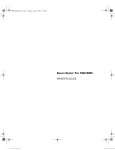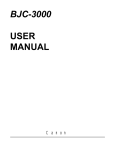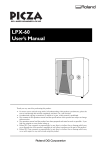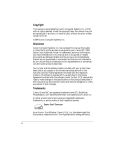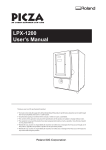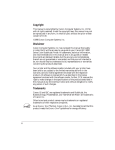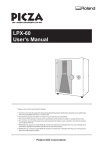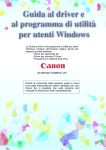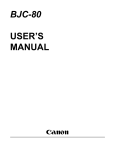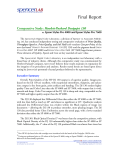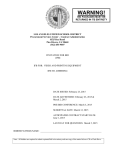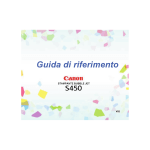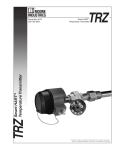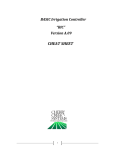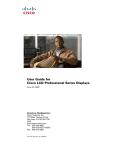Download BJC-7000 User`s Manual
Transcript
BJC-7000 USER’S MANUAL Canon Contents 1 Introduction Supplies and Accessories BJ Cartridges and BJ Tanks Canon Specialty Papers Getting Help From Canon Servicing the Printer 2 Using the Printer With Windows Installing a Printer Driver Printing a Document Printer Setup Within Windows 95 Opening the Printer Properties Dialog Box in Windows 95 Using the Printer Driver in Windows 95 Printer Setup Within Windows 3.1 Accessing the Printing Options The Windows Tabs Specifying Your Printing Options Recommended Print Mode Settings Changing the Print Mode Using Cartridge Detection and Pause Page Printing Speed Versus Color Ways to Improve Print Speed in Windows 3 Paper Handling Selecting Paper Types Paper Gu1idelines Printer Settings for Various Print Media Loading Paper Automatically Feeding Paper Auto Feed Guidelines Manually Feeding Paper Printing On Envelopes Using Canon's Specialty Papers Specialty Paper Guidelines Canon's High Resolution Paper HR-101 Fabric Sheets FS-101 4 Maintaining the Printer Printer Guidelines Cleaning the Printer Printing the Nozzle Check Pattern Printing the Nozzle Check Pattern From Windows Printing the Nozzle Check Pattern Using the Operator Panel Checking the Nozzle Check Pattern Cleaning the Print Heads Cleaning the Print Heads From Windows Cleaning the Print Heads Using the Operator Panel Deep Cleaning the Print Heads Deep Cleaning Using the Printer Driver Deep Cleaning Using the RESUME Button BJ Cartridge Guidelines Replacing BJ Tanks and BJ Cartridges BJ Cartridge and BJ Tank Maintenance Replacing the BJ Cartridges Replacing a BJ Tank in the BC-61 Color or BC-62 Photo BJ Cartridge Storing a BJ Cartridge Transporting the Printer 5 Troubleshooting Identifying Your Printer Problem Basic Problems Clearing Paper Jams Appendix A Specifications Printing Specifications BJ Cartridges General Introduction Congratulations on your purchase of the Canon BJC-7000 Series Color Bubble Jet™ Printer. We appreciate your choosing this printer to meet your printing needs. The BJC-7000 Series printers offer excellent print quality and fast print speed using both color and black inks. We are certain you will be satisfied with this advanced Bubble Jet technology. This chapter: Lists the supplies and accessories you can purchase for the printer Describes Canon's customer support services Supplies and Accessories Your BJC-7000 Series printer supports excellent and unique print media options that will allow you to produce dazzling, professional, and fun presentations. All of these print media are specially designed and manufactured to work with your Canon color printer so you can produce the finest output possible. Canon has an extensive dealer network equipped to offer you supplies as you need them. To find a dealer near you, call the Canon Referral Service at 1-800-848-4123. If supplies are not available from your local dealer you can order directly from Canon by calling 1-800-385-2155. BJ Cartridges and BJ Tanks You can use the following BJ cartridges with the BJC-7000 Series printers: BC-61 Color BJ Cartridge BC-60 Black BJ Cartridge BC-62 Photo BJ Cartridge You can purchase the following BJ tanks for use in the BJ cartridges: BCI-61 Color BJ Tank for the BC-61 Color BJ Cartridge BCI-62 Photo BJ Tank for the BC-62 Photo BJ Cartridge BJ cartridges contain the Bubble Jet print head and BJ tank, while BJ tanks contain ink only. Canon has more engineers dedicated to creating quality ink for providing the best results for output on Bubble et printer than any other organization. Canon does not prohibit the use of third-party inks and the use of third-party inks does not invalidate the product's limited warranty. However, Canon cannot guarantee the quality or performance of your printer when you are using inks from other suppliers. Canon's limited warranty does not cover damage caused to Canon's Bubble Jet products that is attributable to the use of third party parts or supplies, including inks. The limited warranty remains in effect for its life once that particular damage has been properly repaired. For optimum printing results, Canon recommends that you use only Canon BJ cartridges. Canon Specialty Papers Canon manufactures numerous specialty papers, including: o High Gloss Photo Film HG-201 o Glossy Photo Paper GP-201 o High Resolution Paper HR-101 o T-Shirt Transfers TR-101 o Greeting Cards GC-101 o Fabric Sheets FS-101 o Back Print Film BF-102 o CF-102 Transparencies See Chapter 3, Paper Handling, for details on Canon's Specialty Papers. Getting Help From Canon Canon Computer Systems, Inc. offers a full range of customer technical support options including*: o 24-hour, 7-day-a-week, toll free automated support for troubleshooting issues on most current products (1-800-423-2366) o Speak to a technician free of service charge (currently Monday through Friday, 8:00 a.m. to 10:00 p.m. EST and Saturday, 12:00 p.m. to 6:00 p.m. EST, excluding holidays) for products still under warranty** (1-757-4132848) o Speak to a technician (currently $24.99) during holidays and days/hours not listed above regarding urgent product questions or for products no longer under warranty (1-800-423-2366) o E-mail support via the Canon Computer Systems, Inc. Web site (www.ccsi.canon.com) o 24-hour, toll-free Fax Retrieval System (1-800-526-4345) o 24-hour Bulletin Board Service (1-757-420-2000) *Support program specifies subject to change without notice. **Refer to individual product information for warranty details. Canon Canada Customer support for Canadian residents is available 24 hours a day (seven days a week) at 1-800-263-1121 In other countries contact your Canon Dealer. Servicing the Printer The Canon BJC-7000 Series Color Bubble Jet Printer is designed with the latest technology to provide trouble-free operation. The Warranty Card that comes with the printer describes Canon's limited one-year warranty for your Bubble Jet printer. Be sure to read the warranty information to find out about the different service options available to you. Save your sales receipt for proof of purchase. In the event that your printer needs service, you will need your proof of purchase to obtain warranty service. If you feel your BJC-7000 Series Color Bubble Jet Printer needs servicing, contact Canon on the World Wide Web to locate the Canon Authorized Service Facility (ASF) nearest you. If you do not have access to the Web, you can call Canon (see page 1-4). Using the Printer With Windows This chapter describes how to use the printer with your Windows applications. It includes: o Installing a printer driver o Printing a document o Printer setup within Windows 95 o Printer setup within Windows 3.1 o The Windows tabs o Printing speed versus color Before using your printer for the first time, it's a good idea to perform print head alignment to obtain optimum print quality. See your Quick Start Guide for details. Installing a Printer Driver Before you can use any type of printer with your computer, you must install a printer driver. The printer driver tells the computer what kind of a printer you are using. The printer driver also controls the various settings, such as print quality an paper type. You define these settings within the printer driver, and the printer driver then communicates the settings to both the computer and the printer. You must install the BJC-7000 Series Printer Driver for Windows before you can use the printer with your computer. See your Quick Start Guide for instructions. Printing a Document This procedure describes the general steps required for printing from various Windows applications. The exact steps for printing a document may vary depending on the application program you are using. Refer to your software application's documentation for the exact printing procedure. 1 Start your application. Start the program you are using to create the document, and open the document you want to print. 2 Make sure the Canon BJC-7000 is selected as your default printer. Choose Print Setup from the File menu. Click on Setup button if you want to make any adjustments as appropriate for printing your document. (See Printer Setup Within Windows 95 or Printer Setup Within Windows 3.1 for details.) Select OK to close the Print Setup dialog box. 3 Choose Print from the File menu. After making any necessary changes to the printer parameters, select OK to start to the print job. Printer Setup Within Windows 95 You can use the printer with all your Windows 95 applications. Opening the Printer Properties Dialog Box in Windows 95 You can open the Properties dialog box in one of the following ways: From within any Windows application, you can select the Print or Print Setup command. From the Printers folder, you can select the printer and then select the Properties command from the File menu. From the Printers folder, you can select the printer, click the right mouse button, and then select Properties from the drop down list. Using the Printer Driver in Windows 95 The printing options are displayed on the following Windows 95 tabs: General, Details, Paper, Graphics, Setting, and Control. See The Windows Tabs section (page 2-5) for details. For detailed information on any of the printing options, you can use the Windows 95 on-line Help in the following ways: Use the right mouse button to click an item on the screen; then click the What's This? command. Click ? and then click an item. Press F1. 1 of 2 4/9/98 9:30 AM Printer Setup Within Windows 3.1 You can use the printer with all your Windows 3.1 applications. Accessing the Printing Options You can access the printing options from the Printers dialog box in the Control Panel, or you can select the Print Setup option available from the File menu of most applications that run in Windows. If the Print Setup option does not appear in the File menu for your application, refer to the user's manual supplied with the application. It should provide information about changing the printer setup parameters. In Windows 3.1, the printing options are displayed on these tabs: Paper, Graphics, Setting and Control. See the next section, The Windows Tabs, for details. The Windows Tabs The BJC-7000 Series Printer Driver for Windows has several tabs from which you can select your printing options and learn about your printer driver as well as your printer. o General (Windows 95 only) This tab allows you to add comments regarding the printer driver and print a test page or a separator page. (You see this tab when you open the Properties dialog box from the Printers folder, not from within a Windows application.) o Details (Windows 95 only) This tab allows you to specify printer port settings, spool settings, and time-out settings. (You see this tab when you open the Properties dialog box from the Printers folder, not from within a Windows application.) o Main This tab allows you to select your Print Mode. (The printing options on this tab are the same for both Windows 95 and Windows 3.1.) o Paper This tab allows you to specify paper size and page orientation. (the Printin options on this tab are the same for both Windows 95 and Windows 3.1.) o Print This tab allows you to specify background printing and color mode. (The printing options on this tab are the same for both Windows 95 and Windows 3.1.) o Control This tab allows you to initiate print head cleaning, print test pages, move the BJ cartridge so you can change a BJ tank or the cartridge itself, or turn the printer off. (The printing options on this tab are the same for both Windows 95 and Windows 3.1.) Specifying Your Printing Options Be sure to use your on-line help to find out about the settings available for each printing option. o To move between the Windows tabs, click on any of the tabs. o To save the settings and exit, click the OK button. o To cancel your setting selections on a tab, click the Cancel button. o To save your settings without exiting, click the Apply button. o To access the Help file, click on Help button. o When you move the mouse cursor over one of the printing options, a help message appears at the bottom of the tab. o To find out about a setting, click the question mark ? in the upper right corner. Move the larger question mark to the setting you are interested in and click again. Recommended Print Mode Settings You can select the following printing options from the Main tab to achieve the specified results. The Print Mode you select optimizes the printer's settings for print quality, media, paper feed method, and color adjustment. o For normal printing, select one of the following Print Modes: Text For standard printing quality. Auto To print photos or graphics at higher than normal printing quality. Draft To emphasize speed rather than quality; for printing draft texts. o For high-quality printing of photos and graphics, you can use special highresolution paper and select one of the following Print Modes: Graphics For graphics with clearly defined graph and color boundaries. Photo For photos and graphics with many gradation levels. SuperPhoto Highest quality for photos (this setting requires the use of a BC-62 Photo BJ Cartridge). o For printing transparencies, select the following Print Mode: OHP For printing text on transparencies. This setting also prints graphs and drawings nicely. Changing the Print Mode On the Main tab, you can click the Change button to customize the selected Print Mode. You see three tabs. o Quality o Color o Save Using Cartridge Detection and Pause Page On the Control tab, click on Custom Setting to enable or disable Photo Cartridge Detection and/or Pause Page. Printing Speed Versus Color The BJC-7000 Series Printer Driver for Windows can interpret and translate the full spectrum of colors, up to 16.7 million colors. When printing in color, there is a significant increase in the amount of information that the driver has to interpret and translate. When printing black ink only, the driver has only one color to interpret. By decreasing the amount of colors that the printer driver has to interpret, you can significantly decrease the time needed to translate the information. This will speed up the overall printing process. Ways to Improve Print Speed in Windows To improve printing speed, you can try the following: o Turn off the Print Manager in the Windows Control Panel (Windows 3.1 only). This avoids the extra step of sending the print file to the Print Manager and may increase your printing speed by as much as 25%, depending on the computer you are using. o Add a permanent swap file in Windows 3.1. Under the 386 Enhanced icon in the Windows Control Panel, add or create a permanent swap file that is from 4 MB to 9 MB. The computer will be able to prepare the print file faster. See your Windows documentation for instructions. o Avoid diffusion halftones. In the Quality tab, choose Diffusion for Halftoning only when printing final output or photographic images. Choosing a Halftoning setting of Fine/Fast allows documents to print as much as 20% faster because the computer does not need to compute to "best possible position" for each dot. o Avoid color adjustment. In the Color tab, disable the Color Adjustment option. This feature takes longer to process in the computer because it requires special information. o Free up your memory. Use only one software program at a time and unload any screen saving utilities or programs stored in Windows background; this frees up more memory for Windows processing. o Use Monochrome when possible. If you will be printing text in black ink only, enable Monochrome on the Print tab. Print draft documents in Monochrome rather than Color or Auto. o Limit the number of colors on each page. The computer will need to calculate and transmit fewer dots. To many colors can make the image confusing and less effective as well as cause the print speed to slow down. o Use primary colors when printing presentation graphics. Use black, cyan, yellow, magenta, blue, green, and red when possible. The computer will need to calculate and transfer less dot information. o User the Draft setting for Print Mode The printer will need to image fewer dots. o Use Plain Paper as the Media Type. The print head will make one or two passes for each printed line. o Use smaller graphics and more white space in your documents. The computer will be able to prepare the print file faster. o Add RAM to your computer. The computer will be able to prepare the print file faster. o Use a computer with a faster processor. The computer will be able to prepare the print file faster. Paper Handling This chapter describes how to use the printer for all your printing operations. It includes: o Selecting paper o Summary of printer settings for various print media o Loading paper o Manually feeding paper o Printing on envelopes o Using Canon Specialty Papers To ensure the best performance of your printer, you'll want to select the best paper and load it correctly. You can stack paper in the sheet feeder to load it automatically, or you can manually feed one sheet at a time. Selecting Paper Types One of the most important things you can do to assure the best possible performance of your Bubble Jet printer is to select the correct paper. Your printer produces letter quality print on most plain bond papers, including cotton bond and photocopying papers; it does not require special ink jet papers. However, the print quality varies with different paper types. Be sure to test a type of paper before you purchase a large quantity. Plain Paper The printer supports paper sizes of letter, letter plus, legal, A4, and A4 plus in portrait orientation. You can use regular copier paper, cotton bond papers, and typical letterhead. Always use paper without curls, folds staples, or damaged edges. Copier paper has a preferred side for printing. Look at the label on the package to see which side to print on first. High Gloss Photo Film The Canon High Gloss Photo Film HG-201 features a bright white finish that lends striking visual power to charts, graphs, and photographic images. Use this film to make your presentation materials and graphics look professional. When printing on this film, use the BC-62 Photo BJ Cartridge and select High Gloss Film in the printer driver Glossy Photo Paper Canon Glossy Photo Paper GP-201 is a high gloss, thicker paper that produces the look and feel of a photograph. Use this paper with the BC-62 Photo BJ Cartridge to produce top-quality photo-realistic prints from your printer. On your printer driver, select Glossy Paper when you have Glossy Photo Paper loaded. High Resolution Paper The Canon High Resolution Paper HR-101 is designed to produce photo-realistic quality output with sharp and vivid graphics. For best results, use the BC-62 Photo BJ Cartridge to produce images comparable to your favorite photographs. T-Shirt Transfers Use Canon's popular T-Shirt Transfers TR-101 to create and personalize T-shirts, sweatshirts, aprons, tablecloths, napkins, tote bags, and anything else your imagination allows! Use on any cotton or cotton/poly blend fabric. Your image is printed in mirror image (when you use T-Shirt Transfer mode through the BJC7000 Printer Driver for Windows) so when you iron it onto the T-shirt, the image is viewed correctly. Greeting Cards Get the most out of your Canon Creative or other card making software with Canon Greeting Cards GC-101. These cards give your unique, personalized cards the look and feel of professional cards. You can create cards, invitations, announcements, and more. Fabric Sheets Use Fabric Sheet FS-101 for Canon Bubble Jet printers to print banners, pillow covers, scarves, flags, and other textile items. Use these sheets for appliqués and other craft and sewing projects. Fabric sheets are 9.5 x 14 inches. Back Print Film Canon Back Print Film BF-102 has been specially developed for Canon Color Bubble Jet printers. The film is designed to deliver brilliant, high-intensity color images suitable for business presentations, design work, or professional reports. Back print film is printed on the back (matte nonglossy) side of the film in mirror image and then viewed from the front or glossy side using a backlighting device. For more details, ask a Canon Authorized Dealer for information or refer to the manual supplied with the film. Transparencies CF-102 Transparencies from Canon are recommended. These transparencies produce excellent contrast, sharpness, and color. Assorted Paper Starter Kit If you would like to try some of the papers described above, look for Canon's Starter Kit (SK-101). It contains an assortment of five paper types. If you are printing in an application outside Windows, your software application or printer driver must support mirror image printing in order to use Back Print Film or T-Shirt Transfers. Paper Guidelines When selecting or loading paper, please remember the following: o Attempting to print on damp, curled, wrinkled, or torn paper can cause paper jams and poor print quality. o Use cut-sheet paper only. You cannot use multipart paper. o When using graph paper, the lines may not match because the 1/6-inch line spacing of the printer is slightly less than that of graph paper. o If the print density of your page is very high, light paper stock may curl slightly due to the large amount of ink..If you need to print dense graphics, try printing on heavier stock. o Do not use thicker paper that meets the specifications for this printer. Printing with a paper that is thick enough to come in contact with the print head nozzles may damage the BJ cartridge. Printer Settings for Various Print Media Paper Feed Media Method Limit (Sheets) Plain Paper Auto Approx. 130 High Gloss Photo Film HG-201 Auto 1 Glossy Photo Paper GP-201 Auto 1 High Resolution Paper HR-101 Auto Approx. 100 T-Shirt Transfers TR-101 Auto 1 Greeting Cards GC-101 Manual 1 Fabric Sheet FS-101 Auto 1 Back Print Film BF-102 Auto 10 CF-102 Transparencies Auto 30 Other heavier-weight print media Manual 1 Auto Auto 1 15 Envelopes Single Stack Loading Paper You can stack paper in the sheet feeder to load it automatically, or you can manually feed one sheet at time through the manual feed slot. You can place approximately 130 sheets of plain paper (20 lb or 64 g/m2) in the sheet feeder at a time. You can stack approximately 30 sheets of transparency film or 10 sheets of back print film in the sheet feeder. However, these special media may not advance correctly under unusual environmental conditions (such as extreme temperatures or humidity). If you have trouble with special papers becoming skewed or feeding multiple sheets, do not stack them in the sheet feeder. Manually feed them one sheet at a time. Automatically Feeding Paper 1 Pull the paper support up until it stops. Pull out the paper output tray and its extension. 2 Fan the paper. o For best results, fan the paper before loading it. o Always fan a stack of paper along the edge that will feed into the printer first. 3 Slide the stack of paper into the sheet feeder until it stops. o Align the edge of the paper with the right edge of the sheet feeder. o Secure the stack with the paper guide. 4 Start your print operation. o Make sure the printer is turned on. Auto Feed Guidelines When automatically feeding stacks of paper, follow these guidelines: o Do not open the front cover while printing. This may cause paper jams, smudges, or malfunctions. o Do not leave paper stacked in the printer for long periods of time; longer sheets of paper may become bent or curled over time. This may cause the paper to misfeed or jam. o If your printed page contains lots of graphics, the ink on the page may be damp due to the print density. Remove the page right away and allow the ink to dry. o The capacity of the paper output tray is 20 sheets of paper. To reduce paper jams, remove paper from the output tray before the count reaches 20. o If paper curls after printing, remove it immediately; otherwise, paper jams may occur. o The platen (a roller on the inside of the printer) may become inked if your print data beyond the width of the page. If this happens, clean the platen with a soft cloth. (For details on cleaning the platen, see page 4-3.) o Depending on the density of your printed pages, the ink may need time to dry. Within two to three seconds, the ink becomes smudge resistant. After drying for several minutes, the ink becomes water resistant. o Do not try to load paper into the sheet feeder beyond the paper limit mark or the tab on the right side of the sheet feeder; stacking too much paper may cause paper feeding or printing problems o Make sure there are no gaps between the stack of paper and the paper guide nor the right edge of the sheet feeder. Manually Feeding Paper You use the manual feed function when printing on heavier-weight print media (17 lb to 146 lb, 64 g/m2 to 550 g/m2, or paper thickness up to 0.8mm). 1 Move the manual feed guide to match your paper size. 2 Set up your print operation. o If you are using Windows, you must select Manual Feed in the BJC-7000 Series Printer Driver for the printer to accept manually fed paper. o On the Main tab, click on the Change button. Then in the Quality tab, select Manual Feed for the Paper Feed type. 3 Insert the single sheet. o Slide the paper into the manual feed slot in the back of the printer. o Align the sheet with the left edge of the manual feed slot. o Hold the sheet with the print side facing up. o The printer will automatically load the paper into position. Printing On Envelopes You can stack up to 15 envelopes in the sheet feeder or you can manually feed envelopes one at time. U.S. Commercial number 10 (COM10) envelopes and European DL envelopes are recommended. You may be able to stack envelopes of other sizes in the sheet feeder; however, Canon cannot guarantee consistent performance on envelope sizes other than COM10 and DL. The following envelopes are not recommended because they may cause jams or smears, or may damage your printer. o Envelopes with windows, holes, perforations, cutouts, and double flaps. o Envelopes made with special coated paper or deeply embossed paper. o Envelopes using peel-off sealing strips. o Envelopes in which letters have been enclosed. When you are ready to print on envelopes, follow these steps to stack envelopes in the sheet feeder. (You can also manually feed envelopes one at a time.) 1 Prepare the envelopes. o Arrange the stack of envelopes on a firm surface and press down firmly on the edges to make the folds crisp. o Press all the way around the envelopes to remove any curls and to expel air from inside the envelopes. o To remove curling from envelopes, hold the edges of the envelopes diagonally and bend gently. o Make sure any curls are removed from the flaps of each envelope. 2 Insert the envelopes. o Slide a stack of envelopes into the sheet feeder until it stops. Start your print operation. o Make sure the printer is on. o Align the edge of the paper guide with the left edge of the stack of envelopes. 3 Using Canon's Specialty Papers This selection provides guidelines for printing on Canon's Specialty Papers and describes special procedures required for High Resolution Paper and Fabric Sheets. Specialty Paper Guidelines Be sure to read any instructions that come with your Canon specialty paper. These instructions provide important information regarding how to achieve the highest quality with these papers. For transparency film, back print film, high gloss photo film, and glossy photo paper, follow these guidelines: o When automatically feeding transparencies or back print film, remove each sheet after it is delivered. Do not allow film sheets to stack up. o Let the printed sheets of film or paper dry completely before storing them. Paper type Drying time (approx.) Canon High Gloss Photo Film Canon Glossy Photo Paper GP-201 Canon Fabric Sheet FS-101 Canon Back Print Film BF-102 Canon CF-102 Transparencies 10 minutes 2 minutes 1 hour 15 minutes 15 minutes o When a sheet of film has dried completely, cover its printed side with a sheet of plain (not coated) paper before storing it; this is recommended even if you place the sheets of film in a clear file or plastic holder. o Before loading transparencies or back print film, insert one sheet of plain paper as the last sheet in the stack. o Do not leave the film in the sheet feeder for long periods of time. Dust and dirt may accumulate on the film resulting in spotty printing. o To avoid fading, do not expose the printed film to prolonged sunlight. o Store unused papers and films flat. Do not remove papers from their protective packaging until you are ready to use them. o Store unused film at temperatures between 59 F to 86 F (15 C to 30 C). The relative humidity should be between 10% and 70%. Canon's High Resolution Paper HR-101 Canon's High Resolution Paper HR-101 is designed for high quality printing. This paper is specially coated to produce delicate color output. After using a package of High Resolution Paper (200 sheets), you need to use the cleaning sheet enclosed with the paper to remove paper dust from the printer's rollers; this will help prevent paper feed problems. Using the Cleaning Sheet 1 Set up the printer. o Make sure the paper support and paper output trays are extended. 2 Insert the cleaning sheet. o Remove the two pieces of tape from the sheet. o Insert the sheet with the stick side out (toward you) and down (going into the sheet feeder). o Adjust the paper guide to the edge of the cleaning sheet. 3 Feed the sheet. o Make sure the printer is on. o Press and hold the RESUME button. o The printer beeps once slowly. Continue to hold down the RESUME button until you hear two more beeps. Then release the button. o The printer feeds the sheet and then ejects it. o Use a cleaning sheet once only. Fabric Sheet FS-101 The Fabric Sheet FS-101 for Canon printers comes with a booklet that describes special handling procedures. Be sure to look through this booklet for special information regarding the Fabric Sheets. This section describes specific steps for using Fabric Sheets with the printer. Be sure to follow these guidelines. o To avoid paper jams, smearing, and other problems, do not open the printer's cover during printing. o Use the fixing agent that comes with the Fabric Sheet FS-101. o Do not touch newly printed fabric sheets until the ink is completely dry. This takes about one hour. Printing On a Fabric Sheet 1 Set up the printer. o Make sure the paper support and paper output tray are extended. 2 Insert the fabric sheet. o Insert the sheet with the the cloth side out (toward you) and the open end up (away from the sheet feeder). Set up the BJC-7000 Series Printer Driver for Windows. o In the Paper tab, select A4 for the Paper Size. o Adjust the paper guide to the edge of the fabric sheet. 3 o In the Main tab, click on the Change button. Then in the Quality tab, select Fine for Halftoning and Fabric Sheet for Media Type. To save your settings, use the save tab. o Start the print operation from your Windows application. 4 Dry and then wash the fabric sheet. o Let the printed fabric sheet set for about one hour to allow the ink to completely dry. o When dry, peel the film backing from the printed fabric sheet. o Wash the printed fabric sheet for about three minutes under lukewarm running water to remove extra ink. o Hang the fabric sheet up to dry it again. o Iron the dried fabric sheet with a clothes iron. o See the booklet that comes with the Fabric Sheet FS-101 for details on drying and washing. o Clear enough space in front of the printer for at least one sheet of paper to rest after printing. Maintaining the Printer This chapter covers the care required for your Canon BJC-7000 Color Bubble Jet Printer. It includes: o Printer guidelines o Cleaning the printer o Printing the Nozzle Check Pattern o Cleaning the print heads o Deep cleaning the print heads o BJ cartridge guidelines o Replacing the BJ cartridges o Replacing a BJ tank in the BC-61 Color or BC-62 Photo BJ cartridge o Storing a BJ cartridge o Transporting the printer Printer Guidelines Follow these guidelines to avoid damage to your printer and harm to you or others: o Set the printer on a stable surface. Do not use an angled printer stand. Avoid setting the printer in direct sunlight. o Keep the front cover closed when printing. o Do not set anything on top of the printer. o Make sure the power is off any time you connect or disconnect the AC adapter or interface cable. o Do not unplug the AC adapter unnecessarily. o Do not unplug the printer or turn off a power strip to which the printer is attached when the printer's power is turned on. This may prevent the print head unit from returning to the home position on the right and being capped, which may cause the print head to dry out. This is critical. If left uncapped, the print head may clog and may need to be replaced. o Do not move the mechanism that holds the BJ cartridges. Attempting to move the BJ cartridge holder may damage delicate mechanical parts. o It's a good idea to use a power surge protector. However, never tun off the printer using the power strip. Always use the POWER button on the printer. Cleaning the Printer Your printer requires little routine maintenance. Perform the following maintenance, as necessary, to keep your printer in good operating condition. o Before cleaning the printer, make sure the printer is turned off and the AC adapter is unplugged. o Do not clean the exterior of the printer with volatile liquids such as thinners, benzene, or any spray-type or chemical cleaners; doing so will damage the surface of the printer. o When cleaning the printer, avoid the area near the print head on the BJ cartridge. Do not touch the print head. Ink may leak out and cause stains. Clean the printer regularly to avoid printing problems. Remove any ink mist or paper debris from the interior of the printer using a soft cloth moistened with water. Clean especially well around the platen area. If the rollers become dirty, you can clean them with a small soft brush. Clean the exterior of the printer with a soft cloth moistened with water. Clean away smudges and dust. Do not use paper products (such as paper towels or tissues) to clean the Printing the Nozzle Check Pattern You use the Test Prints option on the Control tab in your BJC-7000 Series Printer Driver for Windows to print a Nozzle Check Pattern. You can use this pattern to check the operation of your printer and your print quality. Before selecting the Test Prints option, make sure paper is properly loaded in the sheet feeder (see Automatically Feeding Paper starting on page 3-6). Printing the Nozzle Check Pattern From Windows 1 Start the printer driver. o Click the Start button, select Settings, and then click Printers. o Right click BJC-7000 and then select Properties. 2 Click on the Control tab. o Then click the Test Prints icon on the left. 3 Click OK to print the Nozzle Check Pattern. o Check the results of the Nozzle Check Patter. See the sample printout on page 4-6. o If any portion of the Nozzle Check Pattern is incorrect, clean the print head. See page 4-7 for details. Printing the Nozzle Check Pattern Using the Operators Panel 1 Load paper. o Load one sheet of letter-size plain paper in the auto sheet feeder. o Do not use a paper size other than letter or A4. 2 Turn the printer off and back on. o Turn off the printer and wait a few seconds. o Press down and hold the POWER button. The printer will beep once. Continue to hold down the POWER button until you hear one further beep then release the POWER button. The test print begins. o Check the results of the Nozzle Check Pattern. See the sample printout on page 4-6. o If any portion of the Nozzle Check Pattern is incorrect, clean the print head. See page 4-7 for details. Checking the Nozzle Check Pattern The Nozzle Check Pattern looks like this when the BC-61 Color BJ Cartridge is installed: If any portion of the Nozzle Check Pattern is incorrect, clean the print head. See the next section for details. Cleaning the Print Heads Your printer is equipped with a print head cleaning function to ensure constant high quality printing. The printer automatically performs print head cleaning each time you turn it on. Cleaning the Print Heads From Windows If you are using Windows, you can execute print head cleaning from the Control tab in the BJC-7000 Printer Driver. 1 Start the printer driver and click the Control tab. o Now click the first Print Head Cleaning icon. 2 Click one of the option buttons. o To clean both print heads, select All Colors. o To clean only the print head of the Black BJ Cartridge, choose Black. o To clean only the print head of the Color BJ Cartridge, select Color. 3 Click Execute and follow the instructions on the screen. o To check the print head performance, prin the Nozzle Check Patter (see page 4-4). o If the results of the Nozzle Check Pattern are not satisfactory, perform print head deep cleaning (see page 4-10). Cleaning the Print Heads Using the Operator Panel 1 Make sure the printer is turned on. o Make sure the green POWER light is on. 2 Press the RESUME button until the printer beeps once. o The POWER light blinks for several seconds while the print head is being cleaned, then lights when cleaning is complete. o This is the same cleaning procedure the printer conducts automatically every time it is turned on. Both print heads are cleaned. o Perform the print head cleaning only when you encounter a print quality problem. Unnecessary and repetitious cleaning will waste ink. o If you execute the print head cleaning while paper is manually loaded, the printer will eject the paper and then perform the cleaning. o If you press and hold the RESUME button until the printer beeps twice, the printer will perform a deep cleaning of the print heads. See page 4-11 for details. Deep Cleaning the Print Heads o Perform print head deep cleaning only after print head cleaning fails to correct the problems in the test print. o You can start print head deep cleaning with the printer driver or with the RESUME button on the printer. o Deep cleaning the print heads consumes ink (more ink than print head cleanings), so deep clean the print heads only after print head cleaning has failed to correct a problem. o Before you begin, make sure both the printer and the computer are turned on. Always perform print head cleaning with the BJ cartridges installed in the printer. Never remove the BJ cartridges from the cartridge holder or touch the print heads. Deep Cleaning Using the Printer Driver Make sure paper is loaded in the sheet feeder. 1 Start the BJC-7000 Series Printer Driver and click the Control tab. o Click the second Print Head Cleaning icon. 2 Follow the instructions on the screen. o A message appears to warn you NOT to start another operation until deep print head cleaning is finished. Click the OK button. o The POWER light flashes during print head deep cleaning and then lights again when deep cleaning is complete. o To check the print heads, print the Nozzle Check Pattern (see page 4-4). If the results of the Nozzle Check Pattern are not satisfactory, repeat these four steps in the following order until the pattern is satisfactory: 1. Clean the print head. 2. Print the Nozzle Check Pattern. 3. Deep clean the print head. 4. Print the Nozzle Check Pattern. Deep Cleaning Using the RESUME Button Make sure the printer is on. o Press and hold down the RESUME button until the printer beeps twice and then release it. o The POWER light blinks during print head deep cleaning and then stays on when deep cleaning is finished. If the results of the Nozzle Check Pattern are not satisfactory, repeat these steps in the following order: 1. Clean the print head. 2. Print the Nozzle Check Pattern. 3. Deep clean the print head. 4. Print the Nozzle Check Pattern. If the problem has not been corrected after deep cleaning the print head four or five times, replace the print head. BJ Cartridge Guidelines The printer's cartridge holder holds two BJ cartridges, one BC-60 Black BJ Cartridge and either one BC-61 Color BJ Cartridge or one BC-62 Photo BJ Cartridge. o BC-60 Black BJ Cartridge Contains the print head unit and black ink only. When you run out of black ink, you replace the complete cartridge. o BC-61 Color BJ Cartridge Contains the print head unit and one replaceable color BJ tank, (cyan, magenta, yellow). You can replace the BJ tank without replacing the print head unit when you run out of any of the color inks. Use the BCI-61 Color BJ Tank with the BC-61 Color BJ Cartridge only. o BC-62 Photo BJ Cartridge Contains the print head unit and one replaceable color BJ tank. Use the cartridge when you want to produce photo-realistic color printing. When used with Canon's High Gloss Photo Film HG-201, Glossy Photo Paper GP-201, or High Resolution Paper HR-101, this ink produces images comparable to your favorite photographs. When you run out of ink, you replace the BJ tank. Use only the BCI-62 Photo BJ Tank with the BC-62 Photo BJ Cartridge. Replacing BJ Tanks and BJ Cartridges The actual amount of ink that you use will vary depending on the print density of a page. If the majority of your output is graphics, you may need to change cartridges or tanks more often than when you are printing text only. See Appendix A, Specifications, for details on the life expectancy of the BJ cartridges. You may need to replace the BJ cartridge or a BJ tank when any of the following conditions exist: o Poor print quality If you notice a deterioration in the quality of printed pages, perform a test print and clean the print heads before you decide to replace the BJ cartridge. o 3 Beeps When the BC-60 Black BJ Cartridge runs out of ink, the printer will beep three times and stop printing. Replace the BC-60 Black BJ Cartridge. o 4 Beeps When the BC-61 Color BJ Cartridge and BC-62 Photo BJ Cartridge runs out of ink, the printer will beep four times and halt printing. Replace the color BJ tank. o It's a good idea to replace the BC-60 Black BJ Cartridge if it has been in use for more than one year. Canon has more engineers dedicated to creating quality ink for providing the best results for output on Bubble Jet printer than any other organization. Canon does not prohibit the use of third-party inks and the use of third-party inks does not invalidate the product's limited warranty. However, Canon cannot guarantee the quality or performance of your printer when you are using inks from other suppliers. Canon's limited warranty does not cover damage caused to Canon's Bubble Jet products that is attributable to the use of third party parts or supplies, including inks. The limited warranty remains in effect for its life one that particular damage has been properly repaired. For optimum printing results, Canon recommends that you use only Canon BJ cartridges and BJ tanks. BJ Cartridge and BJ Tank Maintenance The most important thing you can do to extend the life of your printer and to ensure optimum print quality is take care of the BJ cartridges. Spilled ink can stain any surface. Open BJ cartridges and BJ tanks carefully, and follow the guidelines presented here to protect against spilled ink. o Protect all surrounding surfaces (such as floors, furniture, and clothing) before opening any BJ cartridge or BJ tank. o If you are using both the BC-61 Color BJ Cartridge and the BC-62 Photo BJ Cartridge, make sure you store the cartridge not being used in the Ink Cartridge Storage Box. o Keep BJ cartridges and BJ tanks in their sealed containers until you are ready to use them. o Do not remove the BJ tank from the BC-61 Color BJ Cartridge or the BC62 Photo BJ Cartridge unnecessarily. This may cause the ink to clog. o If spilled, the ink is difficult to remove. Therefore, it's a good idea to keep the BJ cartridges and BJ tanks out of the reach of children. o Do not touch the print head area on the BJ cartridges. Ink may leak out and cause stains. o Use the SB-60 Ink Cartridge Storage Box for the BC-61 Color or BC-62 Photo BJ Cartridge only. Do not attempt to store a BC-60 Black BJ Cartridge in this storage box. Hold the BJ cartridge on the sides only. Do not touch the silver plate on the bottom of the BJ cartridge or the silver metal or circuit area on the side. The metal area may become hot during printing. Replacing the BJ Cartridges The following procedure describes how to replace the BC-60 Black Cartridge (when it has run out of ink) or how to switch the BC-61 Color BJ Cartridge with the BC-62 Photo BJ Cartridge. When switching from the BC-61 Color BJ Cartridge to the BC-62 Photo BJ Cartridge (or vice versa), be sure to replace the entire unit. Do not insert a BCI-61 Color BJ Tank into a BC-62 Photo BJ Cartridge, nor a BCI-62 Photo BJ Tank into a BC-61 Color BJ Cartridge. Before starting, make sure the printer's power is on. 1 If the print head is hot, it may not move until it has cooled down. Never attempt to force the cartridge holder to the left manually. Wait a few minutes for the print head to cool down, then press the CARTRIDGE button again. 2 Remove the BJ cartridge. o If you are removing the BC-60 Black BJ Cartridge, pull up on the left cartridge to remove it. o If you are removing the color cartridge (either the BC-61 Color BJ Cartridge or BC-62 Photo BJ Cartridge), pull up on the right cartridge to remove it. 3 Discard or store the removed BJ cartridge immediately. o If you are discarding a used BJ cartridge, do so immediately. o Handle the used BJ cartridge with care to avoid spilling ink on your hands or clothing. o If you are switching the color cartridges, store the cartridge you removed in the SB-60 Ink Cartridge Storage Box. (The storage box is for the BC-61 or BC-62 only. The BC-60 stays in the printer at all times.) o If necessary, open a new BJ cartridge box. Then remove the cap and tape. 4 Insert the new BJ cartridge. o If you are inserting a BC-60 Black BJ Cartridge, insert it into the left side of the cartridge holder. o If you are inserting a BC-61 Color BJ Cartridge or BC-62 Photo BJ Cartridge, insert it into the right side of the cartridge holder. o Insert the BJ cartridge slightly diagonally into the holder. Make sure the cartridge is aligned with the guides, then press down on the cartridge at the circle mark to lock it in place. 5 Press the CARTRIDGE button once. Then close the printer cover. The printer automatically starts cleaning the print heads and the POWER light blinks. This will take about two minutes. After print head cleaning is finished, the POWER light stays on and the printer is ready for operation. Now perform the print head alignment procedure (see the Quick Start Guide for details). Every time you replace a BJ cartridge, it's a good idea to adjust the print head alignment to ensure optimum print quality. Replacing a BJ Tank in the BC-61 Color or BC-62 Photo BJ Cartridge The BC-61 Color BJ Cartridge or BC-62 Photo BJ Cartridge each contain one replaceable color BJ tank. When the color BJ tank runs out of ink, the printer will beep four times and the error indicator will come on. Leave the BJ cartridge in the printer when replacing a BJ tank. Make sure the printer's power is on. 1 Open the front cover, and press the blue CARTRIDGE button once. o The printer beeps and moves the cartridge holder to the left side of the printer. o The POWER light blinks while the cartridge holder is positioned to the left of the printer. 2 Remove the empty BJ tank. o The color cartridge is on the right. o Press in on the release tab and then lift the BJ tank up and out of the BJ cartridge unit. o Dispose of the BJ tank properly. You may want to place it in a plastic bag to keep from spilling any residual ink. 3 Check the number on the color BJ tank then discard it immediately. o For the BC-61 Color BJ Cartridge, always use a BCI-61 Color BJ tank; for the BC-62 Photo BJ Cartridge, always use a BCI-62 Photo BJ tank. o Handle the used BJ tank with care to avoid spilling ink on your hands, floor, furniture, or clothing. Empty color BJ tanks cannot be refilled. Always discard them immediately. o If a BC-61 Color BJ Cartridge is installed, you must replace the old BJ tank with a new BJ tank for the BC-61 Color BJ Cartridge. o If a BC-62 Photo BJ Cartridge is installed, you must replace the old BJ tank with a new BJ tank for the BC-62 Photo BJ Cartridge. o If you replace the BJ tank for the BC-61 Color BJ Cartridge or BC62 Photo BJ Cartridge with the wrong type of color BJ tank, the printer may malfunction. 4 Remove a new BJ tank from its box. 5 Remove the cap from the color BJ tank. 6 Insert the BJ tank. o Align the color BJ tank with the guides on the holder then press down on the circular mark on top of the color BJ tank. 7 Press the CARTRIDGE button once then close the printer cover. o The printer automatically starts cleaning the print heads and the POWER light blinks. This will take about two minutes. After print head cleaning is finished, the POWER light stays on and the printer is ready for operation. o Perform another test print to make sure the new color BJ tanks are functioning normally. Storing a BJ Cartridge Whenever you unwrap a BJ cartridge, you must either install it in the printer or store it in the Ink Cartridge Storage Box to prevent the print head from dying and clogging. The storage box is for the BC-61 Color BJ Cartridge or BC-62 Photo BJ Cartridge only. The BC-60 Black BJ Cartridge is always in the printer. 1 Open the Ink Cartridge Storage Box. o When opening the Ink Cartridge Storage Box, press in on the release tab that locks the cover in place. wpe63132.gif (9144 bytes) 2 Carefully set the cartridge in the storage box. o You must insert the cartridge correctly or the storage box will not close. o The protective cap must be removed from the cartridge before you set it in the storage box. 3 Close the storage box. o Be sure the lid snaps closed. Whenever you remove a BJ cartridge from the printer, store the cartridge in the storage box (unless you are disposing it). Transporting the Printer If you plan to move the printer from one location to another, or if you want to store it, follow these steps. 1 Turn off the printer's power. o Make sure the print head is in the home position on the right side of the printer. o Remove any paper from the sheet feeder. o Detach the interface cable. o Do not remove the AC adapter. 2 Open the front cover. o Lay two small sheets of plain paper on either end of the printer and close the cover. This ensures a tighter seal between the printer cover and the printer body. 3 Tape the printer. o Tape both ends so the printer cover will remain closed. o On the front of the printer, tape the original protective cover over the paper output slot. o If the protective cover is not available, you can use a piece of heavier-weight paper (such as card stock). Cut the paper so that it covers the paper output slot. 4 Pack the printer. o Pack the printer in its original box with the packing supports. o Make sure the box is marked FRAGILE or HANDLE WITH CARE. o Do not remove the BJ cartridge from the printer or ship a BJ cartridge or a BJ tank from which you have removed the protective cap. An opened BJ cartridge or BJ tank that is not installed in the printer (or in the Ink Cartridge Storage Box) may leak, and the print head may dry out. Troubleshooting Due to today's rapidly changing computer environment, we have placed troubleshooting information in a variety of places to ensure that the most accurate information possible is available. The best way to find current information is through our on-line support services and through our Fax Retrieval System. Online services include the World Wide Web and our BBS. This chapter also contains information to help you solve printer problems. It covers a few basic problems and describes how to clear a paper jam. For complete problem solving information, be sure to use our support services. See Getting Help From Canon in Chapter 1 (page 1-4) for details on Canon's customer technical support options. Identifying Your Printer Problem Before contacting Canon, identify your printer problem and make sure you have the following information: o Product name o Serial number o Place of purchase o Nature of problem o Steps you have taken to solve the problem and the results The serial number is located on the label on the back of the printer. Attempting to repair the printer yourself may void the limited warranty as to that repair. See the limited warranty information that came with your printer for details. Basic Problems The most basic problems you may encounter are "the printer does not print" and " your print quality is not satisfactory." o If the printer does not print • Check all your cable connections • Check your printer driver setup • Check your computer configuration o If your print quality is not satisfactory • Clean the print head • Clean the print head five times • Replace the BJ cartridge o If colors are missing • Perform a Nozzle Check Pattern (see page 4-4) • Clean the print head (see page 4-7) • If necessary, replace the BJ cartridge (see page 4-16) Clearing Paper Jams When a paper jam occurs, the ERROR light comes on and the printer beeps twice. If possible, remove the jammed sheet and press RESUME. If this does not clear the jam, follow these steps: 1 Press the POWER button. o Turn off the printer. 2 Gently pull the paper out with one hand while holding down the printer with the other hand. o If the paper tears off inside the printer, open the printer's cover and remove the paper left inside the printer. 3 Press the POWER button to turn the printer back on. o The POWER light comes on and the print head moves to the home position. o The printer is now ready for printing. Specifications Printing Specifications Printing Method Bubble Jet ink on-demand Paper Handling Automatic feed Manual feed Sheet Feeder Capacity - auto feed only Maximum thickness of stacked paper: 0.5 inches (13mm) Plain Paper (20 lb or 75 g/m²) Approx. 130 sheets (0.5" stack) High gloss photo film 1 sheet Glossy photo paper 1 sheet High resolution paper Approx. 100 sheets (0.5" stack) Transparencies 30 sheets Back print film 10 sheets Fabric sheets 1 sheet T-shirt transfers 1 sheet Envelopes 15 Envelopes (U.S. Commercial number 10 or European DL) Paper Size Letter 8.5" x 11" Legal 8.5" x 14" A4 210 mm x 297 mm Paper Type Recommended High gloss photo Film Canon High Gloss Photo Film HG-201 Glossy photo paper Canon Glossy Photo Paper GP201 High resolution paper Canon High Resolution Paper HR-101 T-shirt transfers Canon T-Shirt Transfers TR-101 Greeting Cards Canon Greeting Cards GC-101 Fabric Sheets Fabric Sheets FS-101 for Canon Bubble Jet Printers Back Print Film Canon Back Print Film BF-102 Transparencies Canon Transparency Film CF102 Envelopes Commercial Number 10 or European DL Paper Weight Automatic Feed 17 to 30 lb (64 to 105 g/m²) Manual Feed 17 to 157 lb (64 to 550 g/m²) Print Speed Monochrome Up to 5 ppm Color Up to 3.5 ppm Print speed may vary with content of the document and the processing speed of the host computer. Print Width Maximum 8.5 inches (215.9 mm) Printable area Margins Margins for full-bleed L 0.25 in. (3 mm) L 0.20 in. (5 mm) R 0.25 in. (3 mm) R 0.20 in. (5 mm) T 0.12 in. (3 mm) T 1.10 in. (27 mm) B 0.28 in. (7 mm) B 1.10 in. (27 mm) Printable area for envelopes To ensure the best print quality, make sure printing on envelopes is well within the printable area described below. BJ Cartridges BC-60 Black BJ Cartridge Print head 608 nozzles = Black and Ink Optimizer Capacity Approx. 900 pages / cartridge (at 1500 characters/ page) BC-61 Color BJ Cartridge Print head 240 nozzles, 80 nozzles for each color (cyan, magenta, yellow) Capacity Approx. 4000 pages / cartridge (at 15% coverage) BCI-61 Color Ink Tank Colors Cyan, magenta, yellow Capacity Approx. 320 pages / tank (at 15% coverage) BC-62 Photo BJ Cartridge Print head 480 nozzles, 80 Nozzles for each color (cyan, magenta, yellow, photo-cyan, photo-magenta, photo-yellow) Capacity Approx. 4000 pages / cartridge (at 15% coverage) BCI-62 Photo Ink Tank Colors Cyan, magenta, yellow, photo-cyan, photo-magenta, photo-yellow Capacity Approx. 180 pages / cartridge (at 15% coverage) General Interface IEEE 1284 compatible parallel interface Acoustic Noise Level Approx. 49 db (A) per ISO 9296 Operating Environment Temperature 41°F to 95°F (5°C to 35°C) Humidity 10% to 90% RH (no condensation) Storing Environment Temperature 32°F to 95°F (0°C to 35°C) Humidity 5% to 90% RH (no condensation) Power Source USA / Canada AC 120 V, 60Hz, 0.65 A Power Consumption 8 watts maximum nonprinting 40 watts maximum printing Dimensions 18.4" (467mm) W x 12.3" (313mm) D x 8.6" (218mm) H Weight Approx. 14.1 lb (6.4 kg) with AC adapter attached












































































